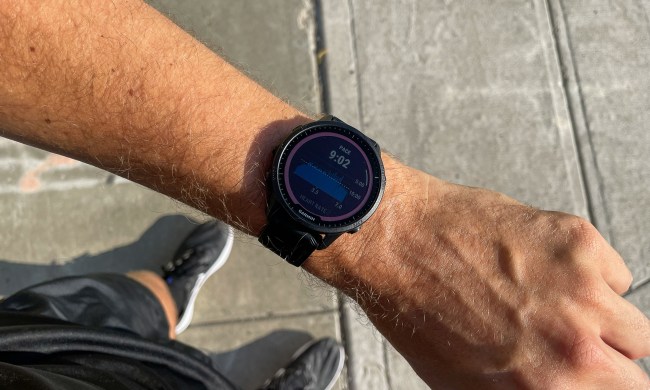Dealing with pain, whether it’s chronic or comes out of nowhere, is one reason many reach for the medicine cabinet to grab some form of relief. Some may call them “happy pills”, but painkillers aren’t a healthy long-term solution, leading some tech startups to push more user-friendly holistic alternatives.
The LumiWave from BioCare Systems is all about that, utilizing LED infrared pods as a method for delivering light therapy, which allegedly helps relieve acute or chronic pain without any side-effects. Pain relief is always in demand, but is there a ray of hope in these lights to actually make a difference? Digital Trends took LumiWave for a spin to find out.
Design and setup
BioCare keeps the LumiWave and its constituent parts neatly packed in the box surrounded by foam, almost indicating how delicate it all is. The three pieces that make up the unit include the strip of four LED pods, a controller, and power adapter.
The device will shut off if it gets too hot, but also the temperatures themselves aren’t that relevant to the treatment.
The controller is the middleman in this setup, where both the strip and adapter plug into either end. Only two buttons adorn the controller itself, triggering the 20-minute treatment (higher temperature) and 30-minute treatment (lower temperature) with a simple press. A belt clip made for the controller helps when using it.
Each pod has 49 LEDs in it, numbering close to 200 total for the entire unit (although the LumiWave Double has two strips for increased capacity). On the high setting, it regulates the temperature at approximately 107.6 degrees Fahrenheit (42 Celsius), while the lower mode drops it to about 105.8 degrees (40 Celsius). How hot it feels may vary, however, but the dosage of infrared light is the same in either setting.
When placed on the affected area, the warmth the light produces is supposed to feel comforting enough to help relieve pain. The heat is a by-product of the LEDs, but in maintaining some temperature control, LumiWave says it is ensuring a proper dosage to avoid tissue damage and skin irritation or burns. That means the device will shut off if it gets too hot, but also that the respective temperatures themselves aren’t that relevant to the treatment.
There is no connectivity here beyond the basics. No Wi-Fi or Bluetooth, nor an accompanying app that you can use to moderate or control anything about the device. Health and wellness tech sometimes adds a mobile element, but not here. In this case, feeling a difference is the only metric for effective relief.
The strap’s clasp and Velcro system is somewhat rudimentary, but it does the job. Fastening it in place for most areas is fairly easy, but much easier around arms or calves where it has more give to wrap around. Otherwise, the strap isn’t necessary. Laying this on the shoulder, hip or back doesn’t allow for much body movement, unless held in place to some degree by tight clothing (not too tight though).
Gauging the science
BioCare points to the safety involved with the LumiWave because there are no side-effects, but there are some conditions that preclude its use. Active hemorrhages, blood clots, and malignancies are non-starters. Pregnant women should never apply it over the womb. Applying it on top of heat-inducing creams or lotions is just asking to get burned. Areas with freshly healed wounds or sensitive skin are better treated with a thin cloth or wrap to act as a barrier.
Consulting a medical practitioner about using the device is always a good idea, though no prescription is required to do so. Treatment shouldn’t exceed three times a day or less than six hours between application.
Light therapy studies go back to the 1960s, but the first clearance for using it in pain relief didn’t happen until the late 1980s. The Food and Drug Administration (FDA) cleared prescription-only LED light therapy in 1994. At the time, low level light therapy, also known medically as photobiostimulation, encompassed both laser and LED-powered devices.
BioCare’s LumiWave prototype got approved in 2005, making it the first LED near infrared light therapy device to get cleared for arthritis pain.
How does it do it? Unlike another naturopathic device like the Quell, which uses electrostimulation of the Vagus nerve for pain relief throughout the body, the LumiWave doesn’t work that way. As a localized treatment, it works with the tissue underneath, where the infrared light penetrates to release nitric oxide to increase blood flow and help tissue repair itself. Healthy tissue produces nitric oxide, whereas damaged tissue can’t do it in the same way.
For that reason, muscles, tendons, and ligaments are the most effective targets. Within those groups are a number of injuries that BioCare claims can be treated with the LumiWave, including fibromyalgia, tennis elbow, carpal tunnel, joint pain, arthritis, tendinitis, and several others.
Feeling the heat
Bearing in mind that the LumiWave is only designed to provide relief, it was always important to remember that it didn’t really have curative properties when using it. Only if the aches and pains were acute might it be effectively lasting, but anything chronic probably needs other treatments to deal with the underlying cause.
The high and low modes didn’t feel warmer or cooler.
I was a good test case, given my recent history of hip and knee sports injuries, which sometimes have nagging effects. In some respects, the LumiWave felt like a heating pad, only with a little light escaping from around the edges. It didn’t take long to feel the temperature rise on direct application to the skin, but it never really hit an unbearable level. When making contact with bone, particularly around the knees, I used a very thin cloth, like one side of a cotton t-shirt, to reduce the impact.
Other than the duration, the high and low modes didn’t feel warmer or cooler. At least I didn’t notice much of a temperature change, and it didn’t get too hot to wear for the duration, either way.
The challenge wasn’t so much the heat, but rather keeping the LumiWave in place. Placing it on my hip required lying down on my left side and draping it over the right hip to maintain contact. BioCare doesn’t use gels or tape to keep the strip from sliding off, which is understandable, but sometimes forces a user to improvise. I had to resort to sports tape or compression sleeve to hold it down, ensuring my skin wasn’t irritated and affording me the flexibility to at least move around a little. Arms and legs were much easier because of the strap.
If I felt anything acute, like tightness in a hamstring or a little ache here and there, the LumiWave did a fine job helping me feel better. For the more chronic stuff, though, I had to be realistic knowing it would more likely have a cumulative effect, rather than an immediate one.
That’s pretty standard for any physiotherapy anyway, but the optics of a device like this may suggest otherwise. Patience is one of those intangibles BioCare doesn’t address enough in its manual. Granted, it’s totally subjective, but since this is not meant to be a total cure, reasonable expectations are necessary.
Setting the bar
BioCare is trying to build confidence with the recent history of light therapy. It’s easy to dismiss something like this as junk science or the latest snake oil, but at least there is some precedent here. Pro athletes have been using light therapy for years to help recover from minor aches to chronic injuries, with the NFL, MLB and U.S. Olympic teams all on board. BioCare says pro golfers, runners and other athletes have used LumiWave too, but didn’t name anyone in particular, presumably for privacy reasons.
A study at Stanford University’s Department of Chemistry looked at near-infrared light absorbance for photothermal therapy. In an interview with Selfhacked, Harvard professor Dr. Michael Hamblin spoke about the efficacy and viability of this kind of treatment as a noted infrared therapy expert. Red Light Therapy is another resource website dedicated to this form of treatment.
Conclusion
Paying $500 for the LumiWave Single (tested here) or $720 for the Double is pricey for most pockets. Relative to physiotherapy costs over time, this might be an investment. Again, however, using the LumiWave for chronic pain should probably be part of wider treatment that also tackles the root cause. This device is more about dealing with the symptoms.
If you’d rather not pop any pills and push your internal organs further with their side-effects, the LumiWave is a drug-free alternative that requires no prescription and carries no residual costs. It’s expensive, but worth a try if you spend a lot on pain relief drugs.





